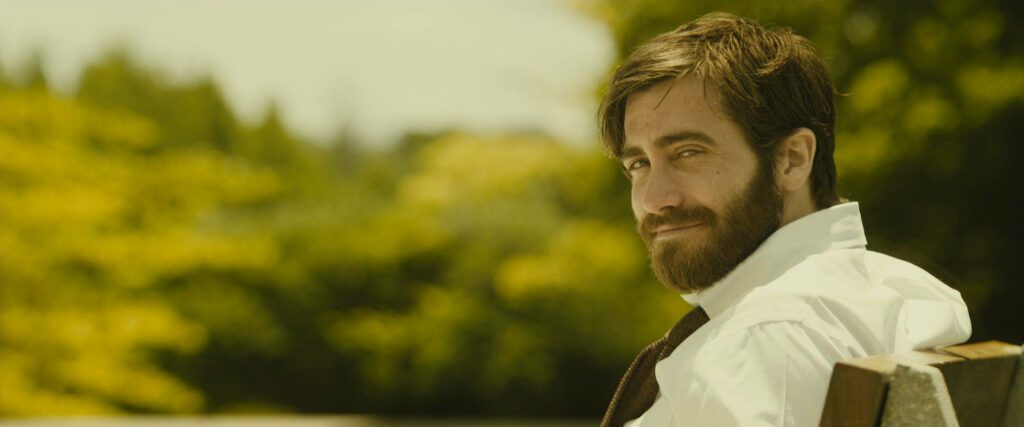
Enemy
2013, directed by Denis Villeneuve
Jake Gyllenhaal plays two characters in Enemy, the slightly nervous history professor Adam Bell and his confident “evil twin”, the bit-part actor Anthony Claire. Of all the details that distinguish them, the most revealing is their apartment buildings. The two structures are similar, even taking into account the prevailing sameness of residential blocks in Greater Toronto. Adam’s high-rise in Toronto has 32 floors, while Anthony’s in Mississauga has 33. The chief difference is in the towers’ footprints: Adam’s is Y-shaped, Anthony’s is X-shaped. The customary biological requisites for a human male are an X and a Y chromosome, so the two buildings support the prevailing interpretation that Adam and Anthony are two sides of the same person. More than that, the buildings also point to the subject of Enemy. Like Villeneuve’s earlier feature Polytechnique, it’s about a man who finds his masculinity inadequate.
To see Adam and Anthony as the same man we must sacrifice any hope of a literal reading, but the story does not leave much room for plausibility anyway. There’s no reason to think they are identical twins, especially with the same scar on their abdomens. To attribute them to a freak accident of genetics would be both unbelievable and disappointingly mundane. The identical snapshots in both men’s apartments should clinch their shared identity. Uniting the two characters resolves many ambiguities, especially in the mother’s dialogue (whose mother is she anyway?), but the real question is what the split between them represents.
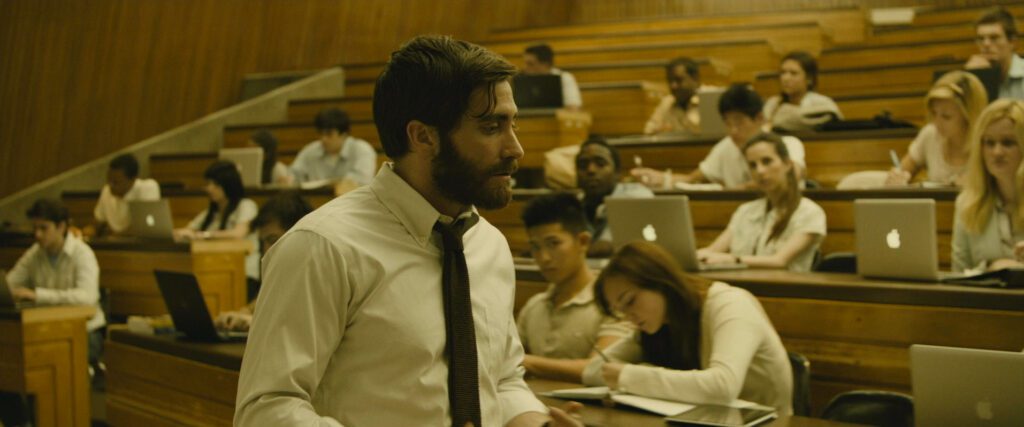
To get at the underlying truth of Enemy, it would be helpful to sort out the clues to get a sense of the one man behind Adam and Anthony. That much is only groundwork, however. The proper goal of interpretation is not to iron out all of a story’s ambiguities, but rather to get at the purpose that motivates everything. If we’re content to leave a few questions open then there should be no pressure to force an explanation onto every detail. Conversely, we should not be so easily satisfied that we rest once we’ve formed a plausible outline of everything we’ve seen and heard.
The protagonist of Enemy is a married man living a double life in more ways than one, not entirely conscious of the contradictions in his behavior. He’s a history professor moonlighting as a small-part actor, with a history of infidelity to his wife Helen. We see his wedding ring in a private men’s club, and he uses a bachelor pad in Toronto for his affair with Mary. Helen already knows of a previous affair. One day a colleague recommends an independent film called Where There’s a Will There’s a Way, and watching it triggers the first spark of self-awareness. He sees himself in the role of a bellhop, which not coincidentally connects to Adam’s surname Bell.
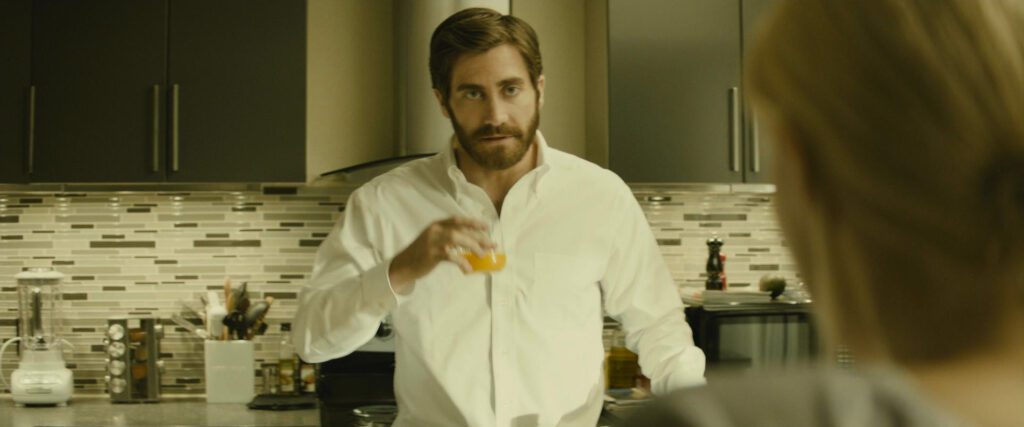
The title Where There’s a Will There’s a Way is an assertion of confidence. When Adam first hears it in the faculty lounge, he misunderstands. He thinks his colleague is stating a belief, not recommending a movie, and he instantly agrees. To agree with that sentence, however, is not the same thing as having the confidence that it expresses; it’s more of a wish to be confident. Confidence is exactly what separates Adam from Anthony. Enemy rarely needs to label the two characters, because Gyllenhaal projects confidence in Anthony and not in Adam. This alone makes it easy to tell them apart, except in the mother’s home where her confidence overrides either one. We can safely say that the confidence we see in Anthony is shallow, because we’ll see how easily it’s shattered.
We must not ignore the fact that Adam discovers his double in a movie. Almost since the birth of cinema, movies have sold men the fantasy of being more confident, more manly, than they actually are. For the price of a movie ticket, any man can identify with the hero and experience ideal manhood. The most prominent posters in the video shop are for Vertigo and Attack of the 50-Foot Woman, both about grown men with insufficient masculinity. Adam’s (or Anthony’s) mother describes his wish to be in movies as a “fantasy”, and when Anthony restages Travis Bickle’s iconic tough-guy act from Taxi Driver in front of his mirror, we should recognize that he’s reaching for a definition of manhood that he’s learned from movies.
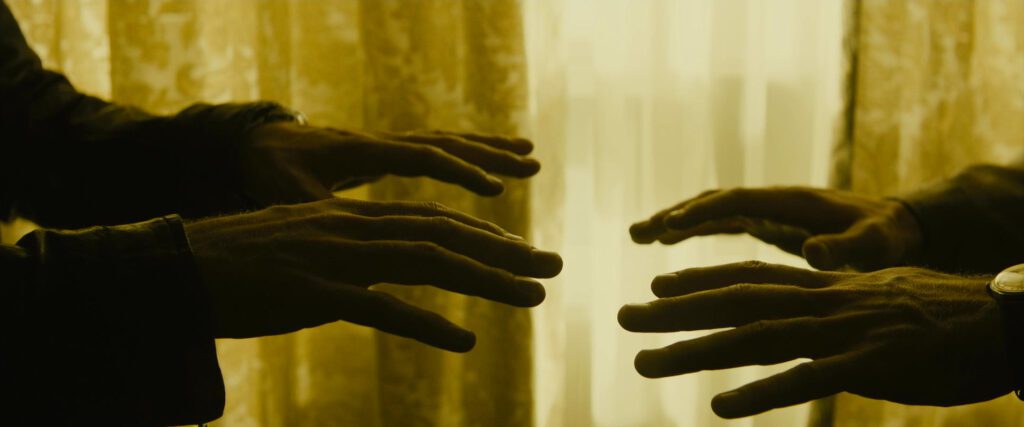
It’s logical that the protagonist would find his manliness in a movie, and equally logical that a movie would awaken his sense of a gap between his real and fantasy selves. It might seem strange that he comes face to face with this gap in a motel room. It’s an odd place for two heterosexual men to have a liaison, but we later learn the reality behind their meeting. The motel room is where Mary discovers he’s married, so it’s also where he becomes aware of the discrepancy between his manly persona and the weak person he actually is. His charade of manliness falls apart when Mary confronts him, shattering his virility with the magic words “You’re not a man!” The subsequent car crash is only a metaphor for the blow to his manhood that sends him humbled – for now – back into Helen’s arms.
The names Adam and Anthony go a long way toward defining Enemy‘s argument. Of all names in Western culture, Adam is the most primal possible reference to manhood, and his abdominal scar marks the spot where God removed a rib to make Eve. Anthony comes from António Claro in José Saramago’s source novel The Double, and the movie hints at a parallel to Adam in the alias Daniel Saint Claire. It’s all very indirect, but the word “saint” and the name “Daniel” tie him to Saint Anthony the Great, a 3rd century Egyptian hermit who had surreal visions like the biblical Daniel. Adam and Anthony lived in opposite worlds, a garden and a desert, but more to the point, both men are famous for facing temptations. Adam was tempted by knowledge, which corresponds to Adam Bell’s role as a teacher and explains his response when Anthony asks why he came looking for his double: “I needed to know.” Anthony was tempted by demons, which accounts for the spiders.
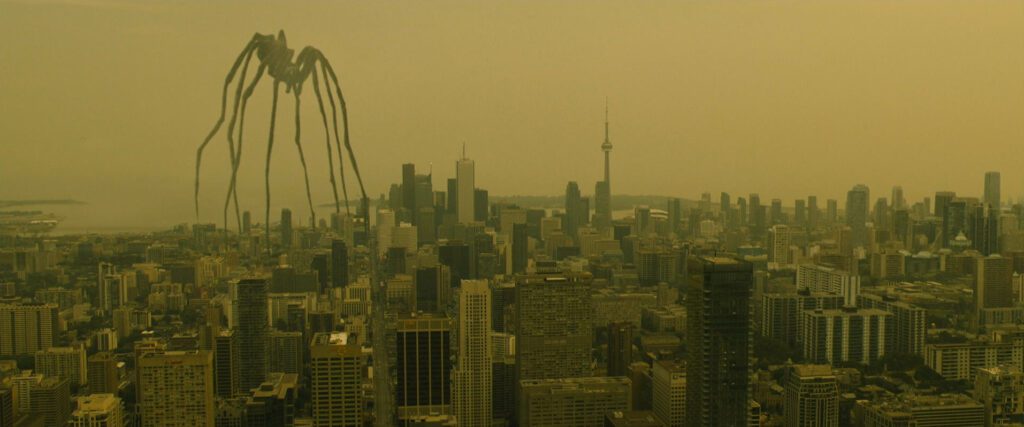
The spiders in Enemy are always associated with women – the tarantula in the sex club, the naked woman with a spider head at the movie’s precise midpoint (in a nightmare apparently shared by both men), the ghostly spider hovering over Toronto right after the mother’s apartment, the spider web cracks in the car wreck, and the enormous spider that replaces Helen at the end. The three living spiders appear symmetrically at the beginning, middle, and end, and they all have to do with fantasy – a sex fantasy in the club, a nightmare fantasy, and a fantasy of escape as Helen’s husband heads for the men’s club once more. The imagery doubtless opens many avenues of interpretation. It captures the fear and fascination that drive men to demonize women, but the basic point is that the spiders represent a specifically male view of women, just as The Attack of the 50-Foot Woman is a juvenile fantasy of a woman capable of controlling men.
Adam’s history lectures allude suggestively to ideas of control, tyranny, and the cycles of history. All of that fits the story of a man fantasizing about his masculinity and going through cycles of temptation and infidelity. He defines his manhood in terms of control, but he also fantasizes about being controlled by women. When Helen appears to him as a spider filling the room, he sighs in resignation as if he’s seen this giant spider before. He’s living his own historical cycle of temptation, pursuit of fantasy, and inevitable disappointment, but the allusions to history in Adam’s classroom tell us that the movie is about something larger. Much of the world’s history is driven by men like him, always reaching for some impossible ideal of manhood.
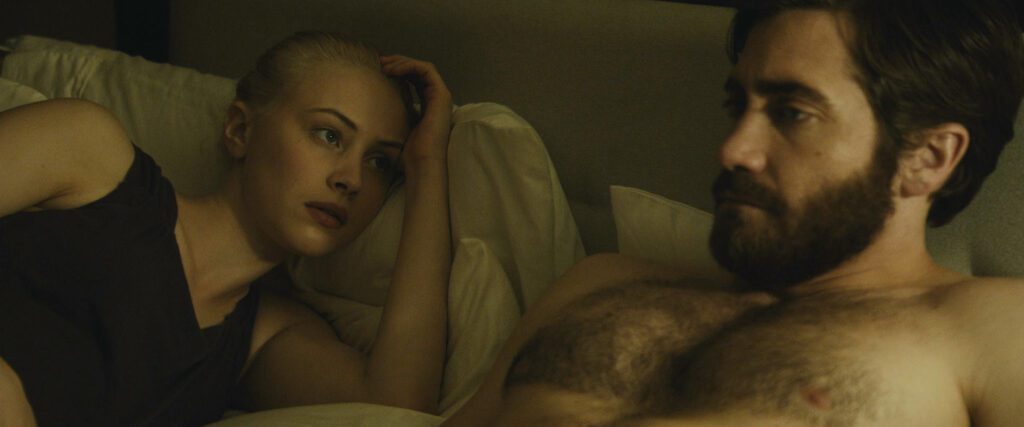
The problem is that men so often view women like spiders, simultaneously tiny and bigger than life. The allusion to Attack of the 50 Foot Woman says a lot. Instead of seeing women as equal human beings, the male imagination keeps insisting on a disparity in size. A man who does this casts himself as an enemy to women, wishing to be superior to them while simultaneously inflating them into huge threatening creatures.
CONNECTIONS:
Meshes of the Afternoon – Experience of infidelity from female/male perspective; multiple iterations of a person
Knife in the Water – Two characters who are essentially the same person; commentary on masculinity
Persona – Ambiguity of identity between two main characters
India Song – Ambiguous hinge between two equivalent characters: shadow on steps between Laotian beggar and vice-consul, spider-head between Anthony and Adam
Taxi Driver – Rehearsal of aggressive question in front of a mirror
Dry Season – Protagonist rehearses his manhood in front of a mirror
Polytechnique – Study of a character who feels his masculinity is threatened
Arrival – Spider filling a room / dream of heptapod filling a room